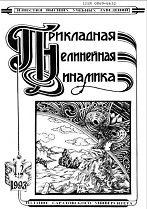|
This article is cited in 1 scientific paper (total in 1 paper)
NONLINEAR DYNAMICS AND NEUROSCIENCE
Thalamo-cortical dysrhythmia and its diagnostic principles
E. Yu. Sitnikova
Institute for Higher Nervous Activity and Neurophysiology of RAS, Moscow
Abstract:
Aim. In the brain of mammals and humans, several widespread neuronal networks are capable of generating spontaneous rhythmic activity. Among them is the thalamo-cortical network, which involves neurons of the thalamus (diencephalon) and in the neocortex and characterized by hierarchical organization. The thalamo-cortical network generates alpha rhythms with a frequency of about 8…14 Hz. Various neurological and psychiatric disorders are known to associate with similar disturbances of thalamo-cortical rhythms, i.e. the thalamo-cortical dysrhythmia. In particular, absence epilepsy, a non-convulsive form of epilepsy caused by disturbances of the thalamo-cortical system. Absence seizures involve brief and sudden lapses of consciousness (i.e., the state of «absence») associated with high-amplitude spike-wave discharges in the encephalogram. The current paper describes morphology of the thalamo-cortical system and diagnostic principles of the thalamo-cortical dysrhythmia. Methods. WAG/Rij rats with genetic predisposition to absence epilepsy were used as a model of the thalamo-cortical dysrhythmia. Electrical brain activity was recorded from the surface of neocortex using implanted electrodes (electrocorticogram, ECoG). Time-frequency analysis of rhythmic activity in ECoG was performed using continuous wavelet transform and the fast Fourier transform. Results. The following hallmarks of the thalamo-cortical dysrhythmia were defined. (1) During the slow-wave sleep, the spectral power in ECoG was shifted from slow to fast frequencies. (2) Short-lasting episodes of 3…12 Hz rhythmic activity with the amplitude maximum in delta (3…4 Hz) and theta (5…9 Hz) ranges were present in the frontal ECoG. (3) The so-called «pro-epileptic» 5…9 Hz oscillations were present in the frontal ECoG. Conclusion. The most pronounced manifestation of the thalamo-cortical dysrhythmia was found in ECoG during the slow-wave sleep. The dysrhythmic mechanism mostly affected short-lasting slow-wave oscillations with a frequency of 3…4 Hz and 5…9 Hz in combination with disturbances of the time-frequency structure of ECoG.
Keywords:
thalamo-cortical network, electrocorticography, rhythmic brain activity, animal model, time-frequency analysis.
Received: 29.10.2019
Citation:
E. Yu. Sitnikova, “Thalamo-cortical dysrhythmia and its diagnostic principles”, Izvestiya VUZ. Applied Nonlinear Dynamics, 28:3 (2020), 282–298
Linking options:
https://www.mathnet.ru/eng/ivp374 https://www.mathnet.ru/eng/ivp/v28/i3/p282
|

| Statistics & downloads: |
| Abstract page: | 248 | | Full-text PDF : | 133 |
|




 Contact us:
Contact us: Terms of Use
Terms of Use
 Registration to the website
Registration to the website Logotypes
Logotypes








 Citation in format
Citation in format 
